Pashupatinath Temple
Pashupatinath temple is one of the most revered religious sites by Hindu pilgrims worldwide, consisting of several temples and monuments besides the main Pashupatinath Temple.
Pashupatinath temple is one of the most revered religious sites by Hindu pilgrims worldwide, consisting of several temples and monuments besides the main Pashupatinath Temple.
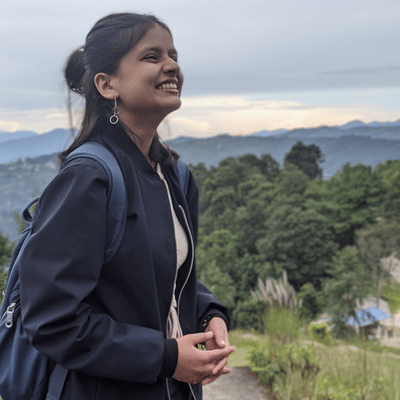
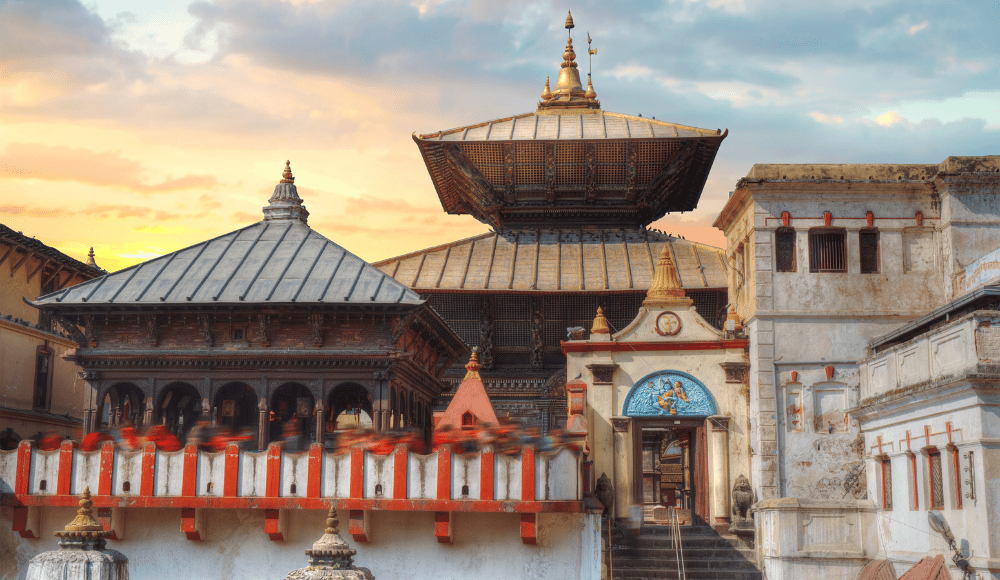
Situated on the holy bank of the Bagmati River, Pashupatinath temple is a place of pilgrimage and devotion. As you look down from the viewpoint of Pashupati, you'll see cremation ceremonies on one side and Puja and rituals on the other. You'll also see couples and families having a good time and others grieving their loss. As strange as this combination is, it is weirdly soothing and serene. Pashupatinath is a site of timeless beauty, where joy and grief exist together in perfect harmony.
Pashupatinath temple is one of the most revered religious sites by Hindu pilgrims worldwide, consisting of several temples and monuments besides the main Pashupatinath Temple. Would you believe it if I said there are 518 mini-temples in a mere area of 246 hectares (2.5 km square/0.97 miles squared)? Not only that, over 1.5 million people visited Pashupatinath during Maha Shivaratri, the most significant festival celebrated there. During major festivities, the queue to visit the temple can extend up to kilometers long. Mind you, those are only Hindu visitors waiting to worship the main idol inside Pashupatinath temple.
You will be restricted from entering the main temple complex if you are not a Hindu. Don’t be disheartened though as there is a lot more to Pashupati than just the main temple. You can still stroll around the premises taking in the beauty of the area. Even though you can not enter the temple, you can still observe the rituals from the terraces right across Pashupatinath. The Sandhya Aarti also takes place on the same stair-like terraces every evening.
Sadhus (holy worshippers of Lord Shiva) can be seen everywhere around Pashupatinath, in their orange and yellow robes, dreadlocks, and ashes/Keshari all over their faces. They are dedicated to the life of a Sanyasi, devoid of all luxuries. While you are there, make sure to ask for blessings from them as most of the Sadhus are very tourist friendly and will even exercise for alms if asked to. You'll also find numerous notorious monkeys in Pashupatinath as well like those in Swayambhunath.
On the premise of Pashupatinath, you will find numerous other temples, Ghats (cremation sites), resting spaces (Chautara), and marketplaces. Guhyeshwari Temple, Gorakhnath Temple, 108 Shivlings, Jyotirlingas, Shivalayas, etc are to name a few. Pashupatinath will provide you with an experience like no other while sightseeing in Kathmandu. It will bring you to a world full of mystery, wonder, and beauty, where faith and devotion intertwine with everyday life's rhythms. Let's have a deeper look at the components of this place of spiritual enlightenment.
|
Site |
Pashupatinath |
|
City, District |
Gaushala, Kathmandu |
|
Province |
Bagmati |
|
Established by |
Prachanda Deva |
|
UNESCO World Heritage Site listed |
1979 AD |
|
Major Attractions |
|
|
Major Celebrations |
|
|
Architecture |
|
|
Opening Hours (Main Temple) |
04 Am - 12 Pm 05 Pm - 09 Pm |
|
Entry Fees |
Free for Nepalese and Indians NRs. 1000 for others |
According to ancient Hindu stories, gods often took the form of animals and visited the earth to take a break from their cosmic duties. On one such occasion, Lord Shiva and his consort Goddess Parvati came to earth, around the area where Pashupatinath is located now taking the form of a deer. They were in love with the place and wished to stay there infinitely. But that posed great dissatisfaction for other gods who then arrived on earth to persuade Lord Shiva to return to his duties.
Lord Shiva refused to return to Kailash which broke out a war between him and other gods. He eventually agreed to return due to all the pressure. But as he fought in his deer form, one of the antlers fell off. That antler was said to be the first Lingham of Pashupatinath worshipped by the devotees of Lord Shiva. Pashupatinath translates to the god of animals in Sanskrit which makes sense considering its origin.
It is said that the Lingham suddenly disappeared at some point in history which caused quite a stir among the pilgrims. But later, a cow was seen fertilizing the soil around a specific area with its milk. It is also said that the cow didn’t produce any milk at any other place or time of the day. So people dug up that area to find the lost Lingham. A small wooden temple was constructed around the Lingham to honor Lord Shiva and the Jyotirlinga (Shivalingha).
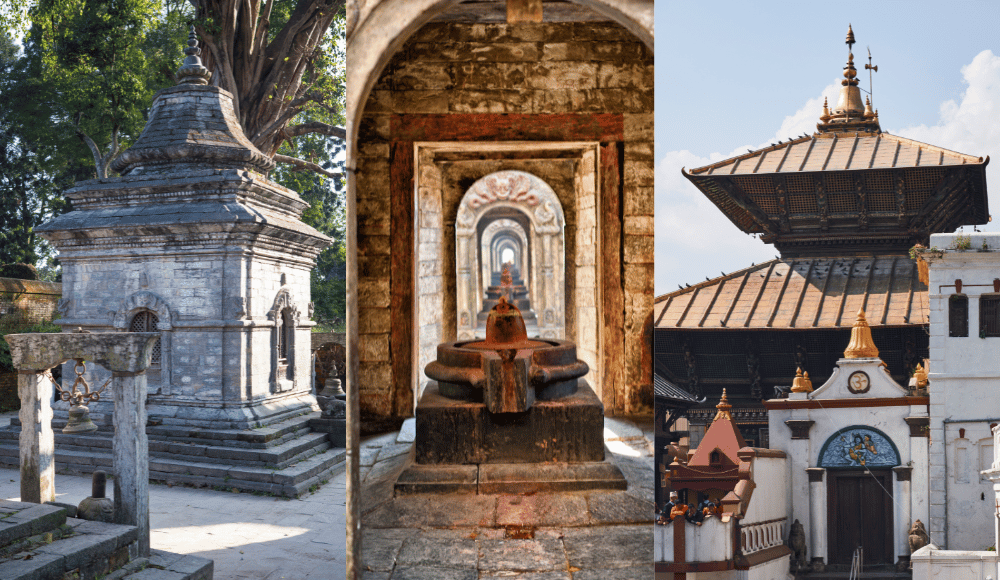
After that wooden temple, Pashupatinath was reconstructed and renovated multiple times in different forms and styles. According to the oldest chronicle, Pashupatinath was constructed in a simple Devalaya (temple) form with a gilded roof in the 5th century CE during the Licchavi era. Later, Supashpadeva commissioned a five-story temple in the same location. For the longevity of the temple and to protect it from various calamities, king Shivasimha Malla demolished the old 5-storied temple and constructed the one in its present form in the 17th century.
Pashupatinath temple is the oldest Hindu temple in Kathmandu, constructed over 1500 years ago. However, most of the surrounding monuments were made in recent centuries. As you can probably tell, it is very difficult to separate myths from historical facts when it comes to religious places. It is nearly impossible to know the exact date of the construction of the Pashupatinath temple. For all we know, it is a jewel of history and a place of devotion for all Shiv worshippers.
There are several elements that bring people in flock to Pashupatinath. The main temple, Vishworup temple with its Mughal dome, Guhyeshwari temple, Yogi caves, cremation ghats, etc are to name a few. Below, I've briefly mentioned the significant attractions in the Pashupatinath premise:
Lord Shiva is referred to by 1008 different names, among all those names Pashupatinath is the most well-known. Pashu translates to animals, and Pati refers to deity, i.e Pashupatinath means the god of animals, more commonly known as the god of all living beings. The temple of Pashupatinath lies on the western bank of the Bagmati river and is the central piece of the whole complex.
Pashupatinath temple is a two-storied pagoda-style temple. Its two roofs are made out of copper and plated with gold. There is a Kalash-shaped spire on top of the temple surrounded by more intricate metalwork. The wooden beams that support the whole temple are covered in wooden carvings of holy figures as if they were paying tribute to the lord Pashupatinath. All the walls are covered in silver coating and accessorized with several beautiful artworks.
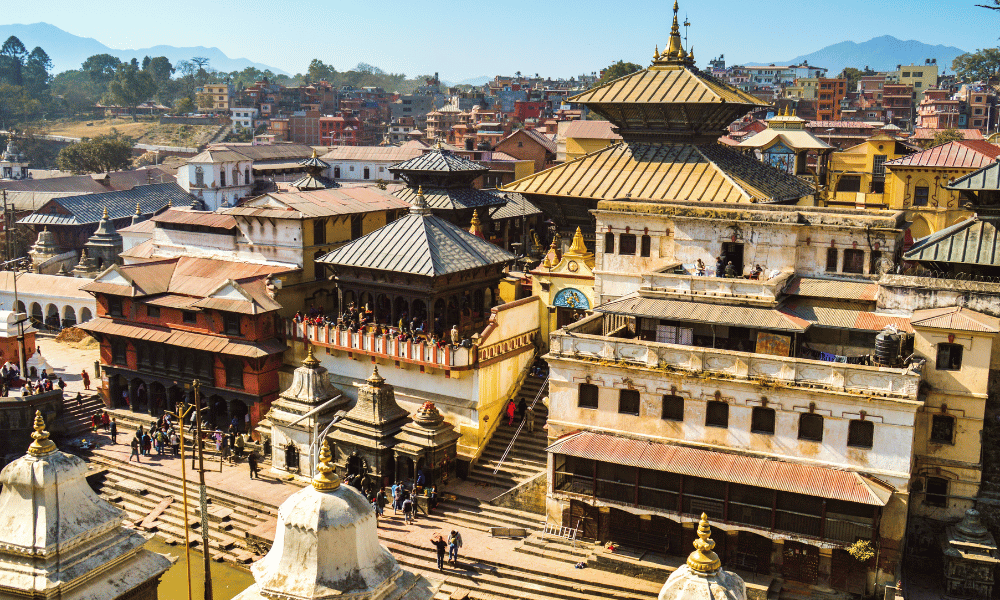
At first instance, it may not look as unique or so different from many other temples in Nepal but as you look closer into the history and its significance, you will be left in awe. The Pashupatinath temple area has four entrances in each direction. If you enter through the western gate, like most visitors, you will be greeted by a giant bronze statue of Nandi (the Vahaan of lord Shiva). The statue is kneeling towards the entrance to the temple and is said to be the biggest of its kind in all of Nepal.
People believe it's inauspicious to look at Nandi without having a look at the idol of Lord Shiva himself, so they focus their gaze on the top spire of the Pashupatinath temple. By doing so, they ensure their next life in human form. Yes, that is another one of many beliefs connected to Lord Pashupatinath. People believe a visit to Pashupatinath ensures your sins are forgiven and you will be reborn as a human in your next life as well but you should not gaze upon Nandi before you pay a visit to the main temple.
Once you get inside the main temple complex, you will again see four doors leading inside the temple. The doors are open between 5 am to 12 pm and 5 pm to 9 pm. Inside those doors is a pre-Vedic Shiva Lingam (Shivalinga/Shivalingha) with 5 faces, each in 4 directions and one on top. You'll hear about many symbols related to the Shiva Lingam and its faces.
The four faces in different directions are said to represent the four Vedas, the body and bottom of the Lingam represent Brahma, Vishnu, 33 Koti Hindu Gods, and the top part/face represents Lord Shiva. The Shivling as a whole is also said to represent Yoni (vagina) and linga (penis), i.e the process of birth and creation of creatures. How one interprets the symbolism is very much up to them and they have a lot of options to pick from.
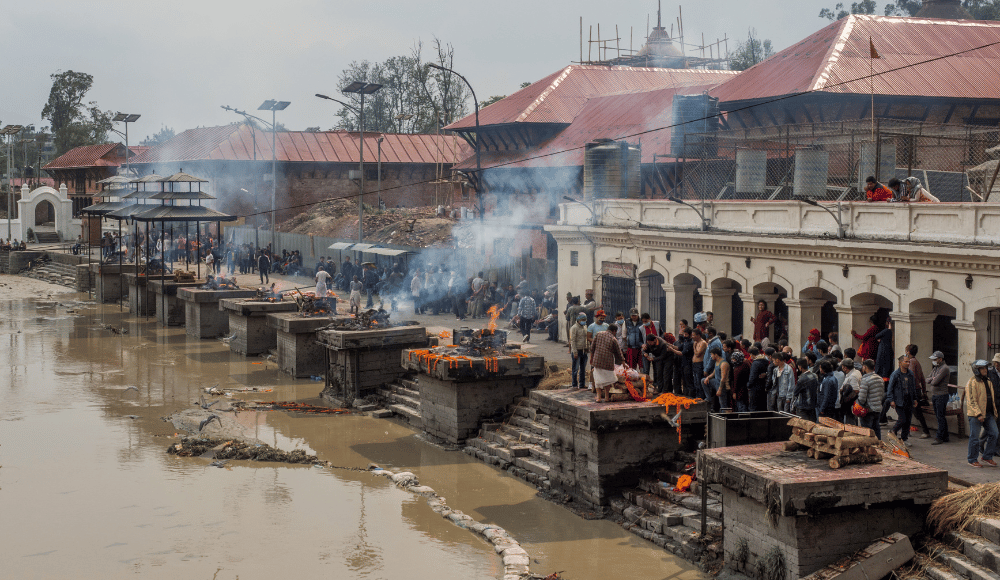
In Hinduism, funeral rituals are aimed at ensuring the deceased person's peace and salvation. The funeral ceremony takes place near the banks of holy rivers (Aarya Ghats), in which the eldest son sets the deceased's physical body ablaze on a funeral pyre. The sons shave their heads, wear white robes and follow a restricted diet for 13 days while staying physically isolated from everyone else.
On the 13th day, a ceremony is held celebrating the deceased's procession to the other world. A ceremony is held every month on the same Tithi (day) throughout the next year to honor the memory and pay respect to their soul. Finally, on the first and coming death anniversaries, an annual Sraddha ceremony is held to bring closure to the bereaved and ensures that the deceased's journey to the afterlife is not forgotten.
There are multiple Aarya Ghats throughout the country but the ones in Pashupatinath are said to be the holiest of all. Pashupatinath has majorly 2 ghats; the Western ghats, and the Eastern Ghats. The western ghats hold cremation ceremonies as they are considered the holiest part of the Bagmati river. It is believed that Lord Shiva spent a lot of time near this bank of Bagmati in his deer form, so anyone cremated here is certain to be reborn as a human in their next life. No wonder, people are dying to be cremated there.
The eastern ghats, however, are more popular for ceremonial rituals than funeral rites. You'll see all kinds of Pujas being conducted there and Sadhus and Pandits performing holy rituals. You'll also see some people fishing in the Bagmati river while others are simply basking in sun taking in all the aura of this mystical environment. There are two footbridges to reach this side of the ghat from Pashupatinath Temple, connected to stairs leading to the terrace above.
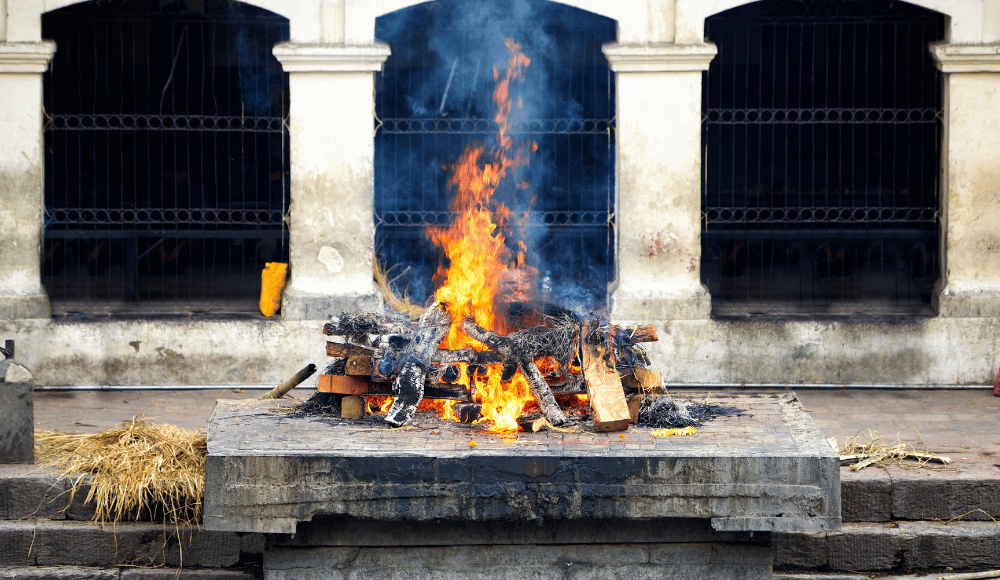
For elderly people, Pashupatinath is where all their sins will be forgiven and they will get a new chance in life in a human form regardless of their Karma. There is an old age home in Pashupatinath, near the western ghats where destitute elderly people reside to live a life closer to their god and have a chance for a holy death. That old age home, popularly known as Panch Dewal (Panch Deval) used to be a religious shrine before turning into a residence for elderly people.
Hinduism glorifies a good death as much as it glorifies a content life and Pashupatinath is a way to attain it. The Aarya Ghats of Pashupatinath premises are always full of activity and life, despite being clouded by death all the time.
After Satidevi's death, lord Shiva carried her around the world in a state of grief and shock for several years. Lord Vishnu took the form of a fly and entered Sati's body to decompose her, and free Shiva of grief to some extent. After the decomposition of her holy body started, 51 parts fell off in different parts of the world. The places where Satidevi's body parts fell were called Shakti Peeth (or Pitha). It is believed that both her knees fell on the site where Guhyeshwari Temple is now located, hence the name.
Guhyeshwari Temple is located 1 Km east of Pashupatinath Temple, on the bank of the Bagmati river. It features a minimalistic architectural design which usually does not attract many people but you will be pleasantly surprised once you step inside the sanctum. This temple is dedicated to Adi Shakti, i.e Parvati (and Satidevi), and is said to depict female force and power. The inside of the temple is decorated with flower motifs and statues of the goddess alongside lord Shiva in his Kapali form.
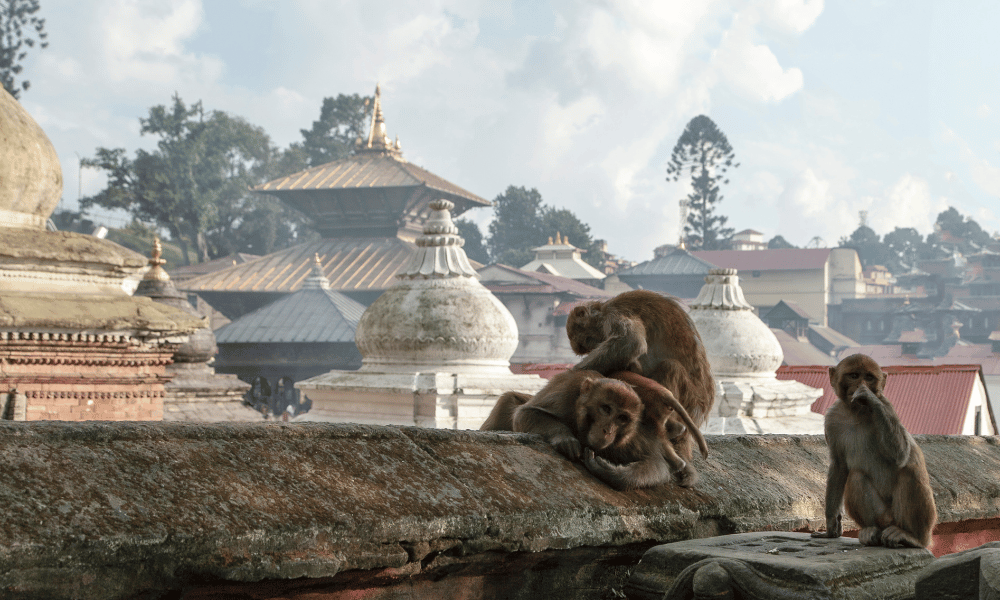
There is another story that states the temple is an ode to Guhyarupini; a form of Parvati, supposedly a secret from everyone (Guhya means secret and rupa means physical form). It is a popular belief that if you get married in the Guhyeshwari temple and get blessings from the goddess, you and your partner will be each other's soulmates for the next 6 lives. Besides the usual Puja, several tantric rituals take place every day inside the sanctum, making it a hot hub for Tantric from all around the country.
If you walk along the stairs from the eastern ghats, right across the Pashupatinath temple, you will reach the Gorakhnath Temple, situated on top of that hill. The temple is dedicated to yogi Gorakhnath, who is said to have started the largest yogi cult of all time. He was a devotee of God Matsyandranath (Machhindranath, said to be the reincarnation of Shiva himself), ready to do anything for his Guru.
Once Gorakhnath misused his tantric powers and was sentenced to 14 years in the Himalayas as punishment. Being as obedient as he was to his Guru Matsyandranath, he walked all the way to the Himalayas and stayed there for 14 years. It is believed that on his journey, he inspired a lot of men to follow his yogic way, hence starting the cult. On his way back from the Himalayas, he spent some time across Pashupatinath temple teaching his followers the way of his Guru.
Once he left, the remaining Yogis continued igniting the Dhuna (holy fireplace) to this day. The Gorakhnath temple was then built in the 11th century with several small chaityas and shrines around it. You will also see many stone Samaadhis (graves) of recognized Sadhus. Other followers of Yogic cults were simply buried under trees around the hill. The Gorakhnath temple is painted red and white and has a big Trishul (trident of Shiva) in front of its entrance.
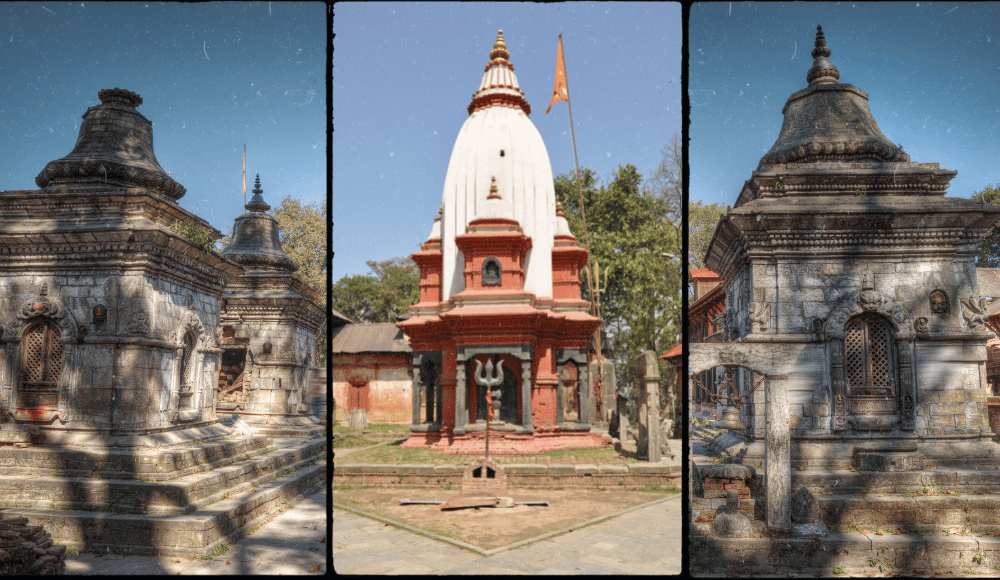
The door to the Gorakhnath temple is usually closed but you will see Sadhus worshipping from outside the temple. Beside the temple, you can visit a small zoo-like conservation area. It was constructed as a way to protect the deer and macaques of the area while letting the tourists get a closer look at them. Macaques are scattered all around the Pashupatinath area so be careful with your snacks and belongings.
Non-Hindu visitors are not allowed to enter the Pashupatinath Temple. However, you can walk up a flight of stairs from the eastern Ghat area and reach the viewpoint. It is a popular spot for visitors to get a panoramic view of the temple complex and the surrounding area. It provides a beautiful view of the temple's pagoda-style architecture and the many smaller shrines and temples scattered throughout the complex.
Those who cannot enter the temple can observe many ceremonies and rituals that take place in the temple. You will also get to see the open-air cremations on the western ghat. The viewpoint also offers a great view of the river and somewhat lush vegetation a little beyond the temple complex. These are a weird mixture of sights but that's exactly what makes Pashupatinath so unique and one of a kind experience.
In addition to these scenes, visitors to the viewpoint can take in the sounds of the temple and its surroundings, including the chanting of mantras, the ringing of bells, the rustling leaves, notorious monkeys jumping around and so much more. If you are looking for time to relax and self-reflect, the viewpoint across the Pashupatinath temple provides you the opportunity to do so.
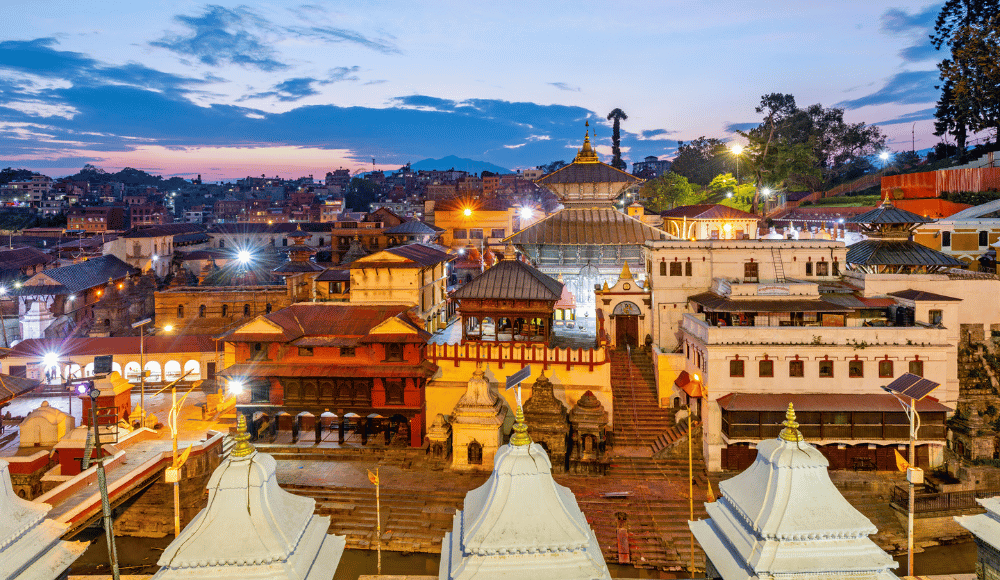
Nearby the Pashupatinath temple, you will come across a bunch of stalls and vendors selling you puja item sets, such as rice, flowers, Belpatra leaves, vermilion powder, and garlands. All these items are used for Hindu religious ceremonies inside the temple complex. This area is more popularly known as the religious market among visitors. You will also find hand-made prasad and spiritual trinkets in the same area
The market in the Pashupatinath area not only serves as the center of commerce but also provides important opportunities for local artisans and traders, who can sell their handmade offerings and religious items to visitors and devotees. These markets help to support the local economy by providing employment opportunities for residents.
Goddess Raj Rajeshwori is considered the deity of knowledge. It is believed that the goddess is served by celestial maidens, the Apsaras, and she gives power to the bow of Lord Shiva. On the southern side of the Pashupatinath temple, there is a temple dedicated to Durga Raj Rajeshwori. Though small, the temple is particularly significant on full moon days, when special worship is performed in her honor.
There is a small trail along the south side of the western ghats that you can follow to reach the Raj Rajeshwari Temple. You probably will be surprised to see a standing buddha statue on the way to the temple, after all these two belong to different religions. That stands to show how deeply intertwined Buddhism and Hinduism are. The standing Buddha statue dates back to the 7th century and is one of the oldest of its kind.
Currently, both the standing Buddha statue and the Raj Rajeshwari temple are not in their best condition. They have succumbed to nature for most parts with vines and trees all around them. As they lie right beside the bank of Bagmati, significantly cleaner than what you'll see in the main city areas, you can lay back a little and enjoy nature.
Every evening at around 6 to 7 pm, the stairs on the bank of the Bagmati river in Pashupatinath are filled with hundreds and hundreds of devotees. The Sandhya Aarti is a daily event that takes place every evening in the Pashupatinath temple and lasts for about an hour. You will see devotees, young and old, enjoying the spectacle of this spiritual journey.
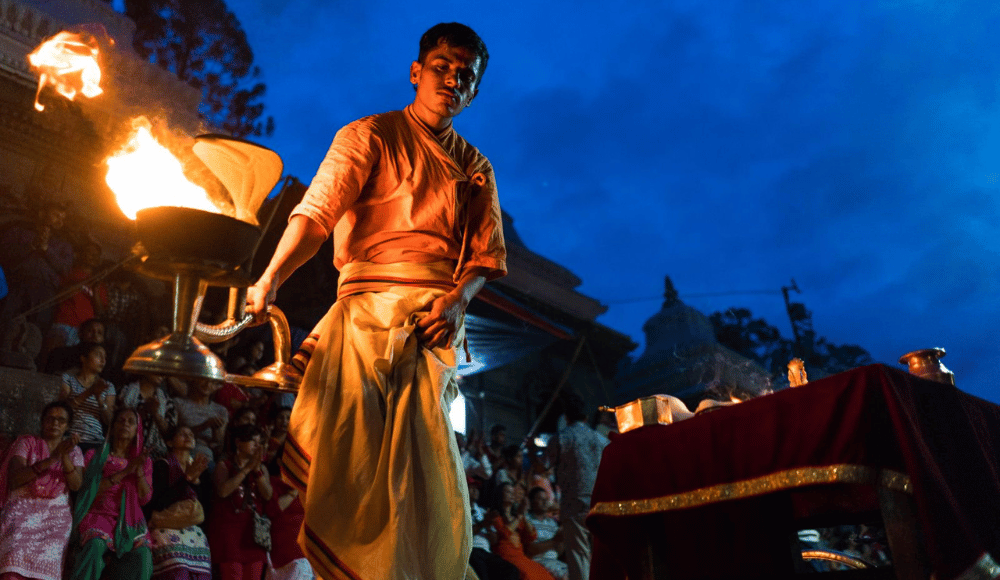
Image by: Alex
As priests start the preparation for the Aarati, the singers and musicians start to play and sing Bhajan (religious songs) while dancers are fully indulged, dancing to the songs. Once the preparations are complete, three priests line up on the bank of Bagmati from where they can get a direct view of the Pashupatinath Temple. They light up the three large oil lamps holding 54 smaller Diyos and coal incense.
Watching the priests perform this Aarati is a truly mesmerizing experience. They first dip the lights four times on the bottom and circle them seven times on the top in perfect sync and coordination. It almost looks as if they were dancing to the beats of the Bhajan while chanting sacred mantras for the lord. The end of the aarti is marked by hailing for the wellness of every living soul and thanking God for the kindness bestowed by him.
Sandhya Aarati at Pashupatinath brings a sense of peace and serenity to the visitors making them forget their pains and worries for a while. So, the next time you visit Kathmandu, make sure to include the Sandhya Aarti in your itinerary for a truly spiritual and soothing experience.
The Pashupatinath temple hosts different major festivals of the country throughout the year including Teej, Haribodhana Ekadashi, new moon and full Moon, etc. Among all the festivals, Maha Shivaratri holds the spotlight. Maha Shivaratri is celebrated on the 14th night of the dark fortnight in Falgun (late Feb to early March) of the Bikram Sambat calendar. On this day, devotees observe a strict fast in honor of Lord Shiva- the supreme power of primal creation, preservation, and destruction.
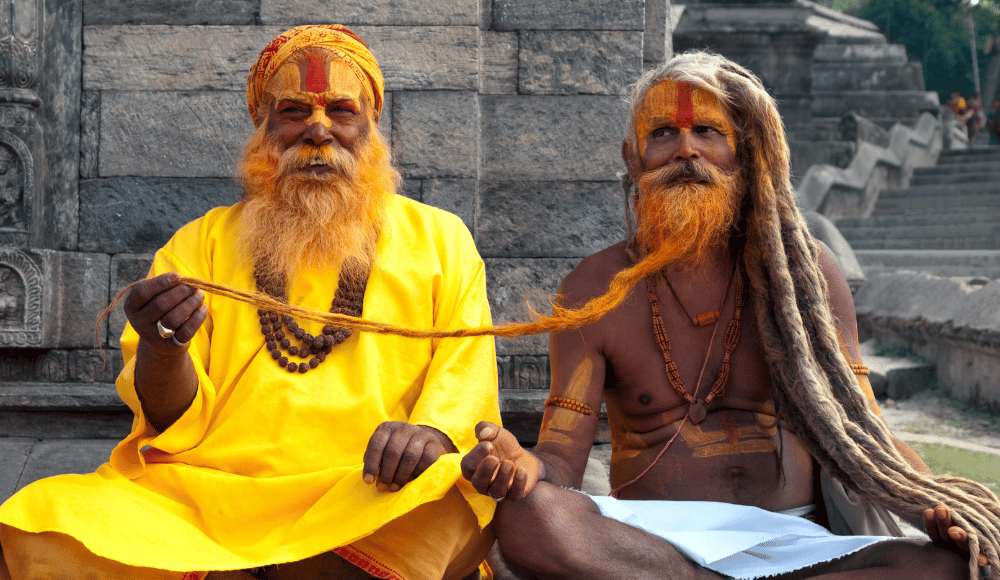
As Shivaratri nears, thousands of Sadhus and Naga Babas (Aghori Sadhus) arrive in Kathmandu from different parts of the world, especially India. They can be seen walking around the area covered in ash and Keshari or taking a tip in the Bagmati river. They have given up on a materialistic life and have devoted themselves to attaining Moksha. They can also be seen smoking weed (Ganja) as the prasad of Lord Shiva. It is said that the start of spring is denoted by the arrival of Naga Babas in Pashupatinath.
Maha Shivaratri is said to be the day when Lord Shiva performed the Tandava, the divine dance of creation, preservation, and dissolution. Some believe that this is the day when Lord Shiva married Goddess Parvati while others believe it to be the day when he manifested himself in the form of a Lingam. Whatever the story is, Maha Shivaratri is always welcomed with a grand celebration in Pashupatinath with over a million devotees visiting during the festival.
Married women observe fast and worship Lord Shiva and Parvati (spouse of Lord Shiva) to shower their grace for a peaceful and blissful married life while the unmarried girls pray for the ideal husband like Shiva. In the evening, the banks of Bagmati are completely covered by the devotees waiting for the Aarati to begin. The Sandhya Aarati of Shivaratri is unlike any other. After performing the usual rituals, the head priest performs Tandava in the Bagmati river facing the Pashupatinath temple with people following his suit on the banks.
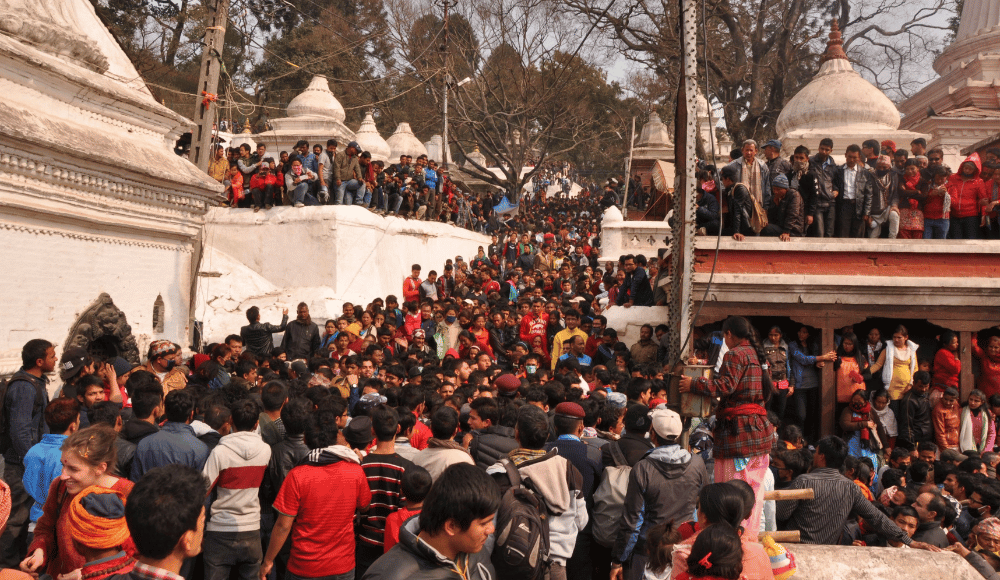
The temple is filled with devotion, love, and reverence for Lord Shiva, and the festival is a celebration of life and spirituality. The temple premises are lit up with diyas, and the air is filled with the sound of bells and the smell of incense. This festival is sure to be a memorable one with a once-in-a-lifetime experience, so make sure to plan your visit accordingly.
Pashupatinath temple is considered one of the holiest Hindu shrines in the world with thousands of devotees visiting every year from all over the world. It is considered to be the second half of the Kedarnath Temple, India which is one of the 4 most important Hindu temples (the Chaar Dham). Its religious significance cannot be overstated as it is deeply rooted in Hindu mythology dating back to ancient times.
In addition to its religious significance, the Pashupatinath area is also culturally rich and is home to many other temples, shrines, and monuments that have historical, architectural, and cultural importance. The area is also considered to be an important center for Hindu philosophy, learning, and spiritual development, and is home to many ashrams and meditation centers where devotees can study and practice Hindu spirituality.
The cultural and architectural richness of the area, combined with its religious significance, make Pashupatinath Temple and its surrounding area a unique and treasured part of Nepal's heritage. It holds immense importance for the people of Nepal as well as Hindu devotees worldwide. Even if you are not interested in the religious aspect, the spiritual aspects of this area are sure to leave you in awe.
The Pashupatinath Temple and its surrounding area have significant importance for both the local community and Nepal's wider economy. As a major tourist attraction, the temple attracts a large number of tourists each year, both from within Nepal and from overseas, who visit the temple, explore the area, and experience its cultural and religious richness.
That, in turn, boosts the local economy by creating jobs and generating revenue through tourism-related activities such as accommodation, food, beverage, transportation, and retail. In addition to its role as a tourist attraction, the Pashupatinath area also serves as an important center of commerce, with many shops, stalls, and markets selling religious offerings, souvenirs, and other keepsakes to visitors.
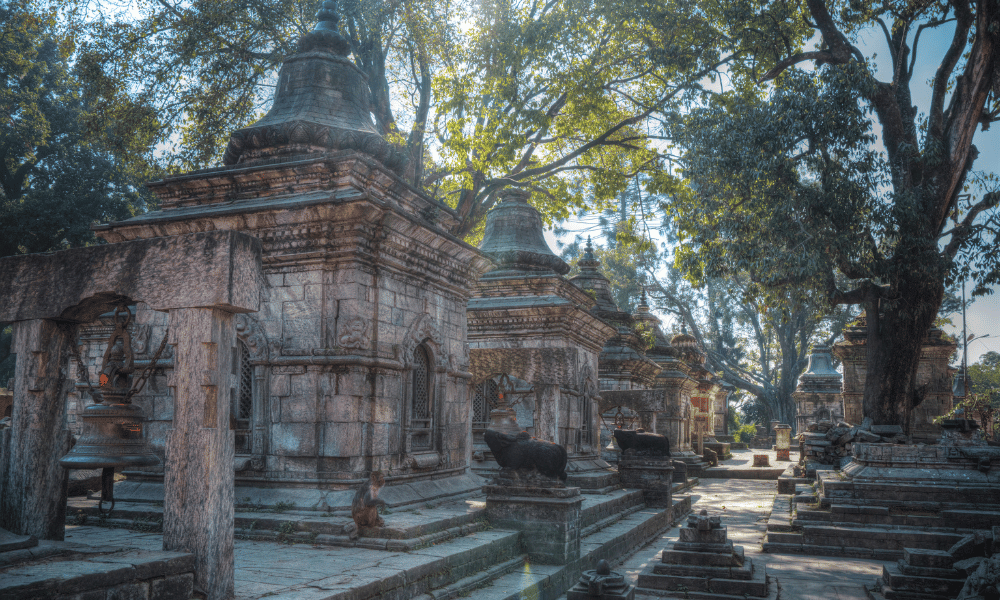
Pashupatinath premise is spread over a large area, requiring constant maintenance and upkeep. This would usually cost the government a huge sum from its pocket but with the establishment of the Pashupatinath Development Trust, the temple has been pretty much self-sustained. The donations from devotees, ceremonial charges, etc. keep the temple up and running while employing hundreds of people.
Pashupatinath is located about 5 km far from Kathmandu Square and only about 2.5 kilometers from the Tribhuvan International Airport. Here are some ways to reach the Pashupatinath Temple from different places:
Taxis are readily available and can take you directly to the temple premise in about 30 to 40 minutes. If you are on a budget, you can take one of the local buses from Ratnapark, Sundhara, or any part of the Ring Road. Depending on the traffic conditions, it can take you anywhere between 40 minutes to an hour to reach the gate of Pashupatinath premises.
The temple is only about 2 kilometers away from the Tribhuvan International Airport, so it's convenient to reach there using any mode of transportation. You can take a taxi directly from the airport or hop on a public bus and get off at Gaushala. Simple, right?
You can take a long-distance bus or a private car to reach Kathmandu and then follow the directions mentioned above for reaching the temple. Alternatively, you can also take a domestic flight to TIA and then follow the aforementioned directions.
Now, you need to keep in mind that no transport will take you directly inside the temple. It is most likely that you'll be dropped at one of the gates, from where you can simply follow the crowd or use maps to reach the main temple.
Pashupatinath temple is open every day from 4 am to 9 pm but remains closed for a few hours after noon (usually 12 - 5 pm). However, the rest of the area is open 24/7 for visitors.
The entry fee for foreigners besides Indian nationals is NRs. 1000. Nepalese and Indian devotees do not require any entry tickets/fees. But you should remember that only Hindu devotees are allowed inside the temple.
|
Nationality |
Entry fee |
|
Nepalese and Indian Nationals |
free |
|
Foreigners |
NRs. 1000 |
Pashupatinath Development Trust allows visitors to conduct special puja on the temple premise as per their requirements. There are set prices for each puja as determined by the trust which is mentioned below:
|
Puja Name |
Cost (NPR) |
|
Panchamrit Puja |
2,100 |
|
Panchamrit puja with Baal bhog |
3,100 |
|
Panchamrit puja with Baalbhog and Rudrabhisek |
7,500 |
|
Panchamrit puja with Laghu Rudrabhisek and Purabhog |
15,100 |
|
Panchamrit puja with Rudrabhisek, Purabhog, Sawalakh (1.25 lakhs) batti aarti |
35,000 |
|
Panchamrit puja with Laghu Rudrabhisek, Purabhog, Sawalakh (1.25 lakhs) batti aarti |
65,000 |
|
Nitya Bhog and day-long puja |
1,71,000 |
|
Ek Diwasiya Maharudri |
3,21,000 |
|
Ekadash Diwasiya Maharudri |
8,00,001 |
|
Ekadash Diwasiya Atirudri |
25,00,000 |
Keep in mind that you will need the receipt of payment a day prior to the puja. And you will need to deposit the amount in a bank designated by the trust. Do not go by a third party to avoid fraud and risks.
If it's your first time in Pashupati, it might be a little tricky to navigate around by yourself. There are several rules everyone is expected to follow. Let's go through the rules first:
Only Hindus are allowed inside the main temple of Pashupatinath.
Shoes and leather clothes should be taken off before entering the temple.
Only 4 Bhatta Pujaris (priests) are allowed to touch the main idol of Pashupatinath (Shiva lingam).
Photos of the inner sanctum are strictly prohibited.
You are not allowed to smoke and drink inside the main temple complex.
So, you have memorized all these rules but are still confused about how to make the most of this trip with the least trouble. Then, here are some tips and guides for you:
The temple is spread over a huge area. Get your belongings and roam around to find out more about life in the area by yourself. Of course, you will need to be respectful and observant but this is the best way to explore the diversity of the Pashupatinath area.
Sit on the benches in the viewpoint and take in the entirety of this serene atmosphere. You might be irked by the open-air cremations and newlyweds taking blessings of Pashupatinath, side by side but that holds the true beauty of this place. Pashupatinath is the place of beginning and end, creation, and destruction.
Arrive at least one hour earlier than your planned schedule. The crowd in Pashupatinath can be unpredictable, setting you back your schedule by hours at a time. To avoid these issues, reach there as early as possible.
Sandhya Aarati is the main highlight of a normal day visit. It is a full package of entertainment, spirituality, culture, and rituals of Pashupatinath. Attending one is sure to soothe your mind and free you of your worries for a few moments, so make sure to not miss it.
I know they look cute and harmless but trust me, they can and will be aggressive if agitated. Do not try to play with them, go near them, or feed them. They have plenty of resources to feed off of so you will be taking risk of being attacked for nothing.
Pashupatinath is home to a large number of Sadhus living a life of a hermit without any worldly pleasures. In most cases, they will be happy to engage in a conversation with you. Some might charge you for it but it's definitely worth it.
Pashupatinath Temple is a popular tourist destination and can get crowded, especially during peak tourist season. Be prepared for long lines and crowds, and plan accordingly. Also, be attentive to your belongings and surroundings.
The origin of the Pashupatinath Temple is unknown. But the first gilded roof was put on the temple by Prachanda Deva in the Lichchhavi era.
Pashupatinath is the oldest Hindu temple in Kathmandu and is one of the most popular tourist spots. The open-air cremation, Sandhya Aarati, Avisheka, etc are all parts of the unique Pashupatinath culture.
Even though the exact date of the establishment of Pashupatinath is unknown, it is believed to be over 2000 years old. However, the modern temple structure was first constructed in the fifth century C.E.
Lord Shiva is believed to hold the power to free beings of their bondage with the physical world and ascend them to their next life cycle. He is considered the master of all living beings which in Sanskrit translates to Pashupatinath.
Yes, the Pashupatinath area has been listed as a UNESCO World Heritage Site since 1979 AD. It is one of the 10 UNESCO heritage sites in Nepal.
Sadyojata, Vamdeva, Tatpurusha and Aghora are the four faces on the Shiva Lingam inside the Pashupatinath temple. The fifth is Ishana, unknowable even to the seers.
The best time of the day to visit Pashupatinath will be in the evening during Sandhya Aarati, or early in the morning. If you are planning your trip to Pashupatinath, you should definitely try to align it with Maha Shiva-Ratri celebrations.